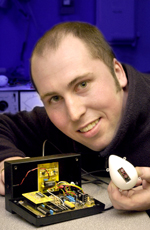Smarter than a normal egg
Published: 10 May 2005
Researchers at the University of Glasgow have recently built some eggs that could be described as downright 'smart'
Researchers at the University of Glasgow have developed electronic egg devices that record crucial information on birds, that has been previously difficult to monitor.
With the help of funding grants from the Universities Federation for Animal Welfare and The Natural Environment Research Council, awarded to Professor Pat Monaghan and Dr Ruedi Nager at the Division of Environmental and Evolutionary Biology (Institute of Biomedical and Life Sciences), it is hoped that these 'smart' eggs can be used to record information without the birds even knowing that it is being done.
Professor Pat Monaghan explains:
"Getting information on heart rate and temperature during incubating is very tricky, since if you approach the birds of course they get disturbed and fly off. These 'smart' eggs overcome these problems by putting mini recorders inside artificial eggs, without the birds even knowing its been done.
"Cunningly concealed inside the egg is a tiny electronic device that records and stores the heart rate and egg temperature; temperature near the nest can also be recoded using another probe. The egg can even record the identity of the bird sitting on it when special bird tags are used."
The eggs have been built by technicians at the Electronics Unit of IBLS.
When birds sit on eggs to incubate them, there is very close contact between the bare patch of skin known as the brood patch, and the egg surface.
Scientists studying avian incubation are interested in how the bird manages to transfer the right amount of heat to the egg to ensure that the chick inside develops in the right way. How much energy the adult has to expend in doing this can vary considerably, particularly in relation to local climatic conditions and how often the bird has to leave the nest to get food, with the eggs having to be reheated when the bird gets back.
Many birds build elaborate nests to offset these costs, such as eider ducks, which line the nest with feathers to help keep the eggs warm. Humans of course take advantage of this and collect this eiderdown when the birds have finished to keep themselves warm. The bird fuels this energy expenditure by increasing its metabolic rate and its heart rate goes up. Heart rate also goes up when the bird is disturbed as, for example, when humans come too close.
A prototype of the eggs has been used to monitor human disturbance of kittiwakes nesting on sea cliffs.
The smart eggs have just flown off to Icleand for use in a project on incubation in eider ducks by Glasgow research student Liliana D'Alba, which proves just how 'smart' they really are.
Media Relations Office (media@gla.ac.uk)
For more details please call the University Press Office on 0141 330-3535.
First published: 10 May 2005
<< May


